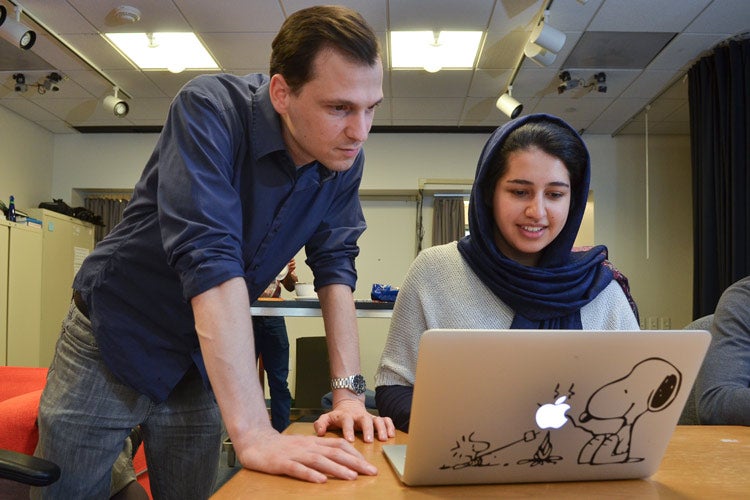|
March 23, 2015
Stanford collaborates on research to help online groups organize themselves
Making decisions and taking actions require leadership tools to minimize infighting and focus the energy on action. By Tom Abate

Assistant Professor Michael Bernstein and graduate student Niloufar Salehi have created an online forum structure to overcome barriers to group action. (Photo: Rod Searcey)
The Internet has simplified many aspects of life: how we communicate, how we relax, how we work.
But technology hasn't changed human nature, and the dynamics of how we interact online can make it harder to reach a virtual meeting of the minds.
"It can be difficult to get a group of people in a room to agree on a course of action, and those difficulties are compounded when people try to work together online," said Niloufar Salehi, a Stanford graduate student who studies human-computer interactions.
Salehi has spent the last two years working with Michael Bernstein, an assistant professor of computer science at Stanford, and Lilly Irani, an assistant professor of communication at the University of California, San Diego, to study how to create an online forum geared toward action.
"It's easy to come together online, act upset and blow smoke," Bernstein said. "We wanted to take it to the next level: What does it take to come together to transform that energy into decisions and the pursuit of common goals?"
Salehi will present the team's findings at the forthcoming Computer Human Interactions Conference in Seoul, South Korea, and their work has already been cited as among the event's top 5% of research efforts.
In essence, the team identified two main barriers to online action – stalling and friction.
Stalling refers to the need to overcome the inertia that prevents people from agreeing on goals and cooperating to accomplish them. Friction is the danger that disagreements will divert participants from their common ends.
Their study group was a forum called Dynamo, whose members included several hundred freelancers who worked through Amazon Mechanical Turk.
MTurk, as it is commonly known, is an Amazon.com service that makes it easy to buy and sell piecework.
The Dynamo research team included Kristy Milland, a 35-year-old Toronto woman and veteran "Turker," as members of this freelance community call themselves.
"Many of us have some form of social anxiety and that makes us reluctant to join any sort of forum," Milland said.
The researchers sought to create a forum structure that enabled members to carry out commonly agreed upon goals, in this case making small changes in their online work environment.
To counteract stalling, members voted on which actions to take to identify the goals with the broadest support.
To minimize friction, forum leaders acknowledged objections and came up with concrete proposals to deal with differences.
"We call this the labor of action," Salehi said, describing the need for online leadership to defuse squabbles, maintain group morale and coordinate action.
The forum achieved some modest successes. Amazon opened up direct payment soon after Turkers staged an effort to draw attention to themselves using the platform, Salehi said.
Dynamo members also created ethical guidelines for academic researchers who hire Turkers to do piecework, as reported by the Chronicle of Higher Education.
For UCSD's Irani, who earned a master's in computer science at Stanford, this project is part of broader effort.
"I want to help ordinary workers create a collective voice that has to be heard," she said.
Bernstein said giving online groups a stronger voice becomes increasingly important as more types of work move online.
In a 2013 paper, Bernstein and several other researchers noted the increasing prevalence of online freelance work and asked themselves whether they, as parents, would encourage their kids to get into it. "In many ways the answer right now is 'no,'" Bernstein said.
For more Stanford experts on human-computer interaction and other topics, visit Stanford Experts.
-30-
|